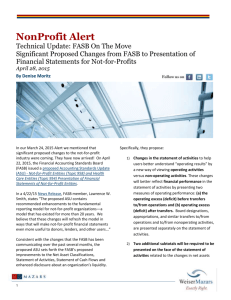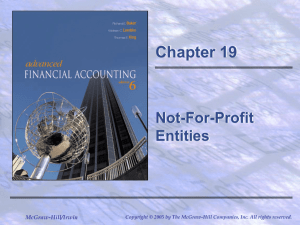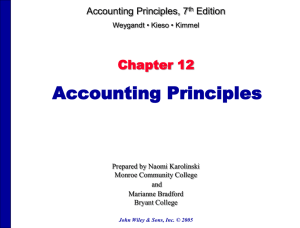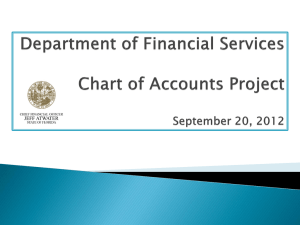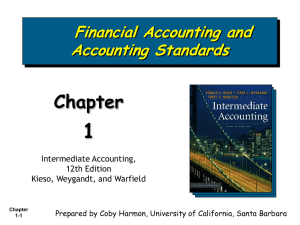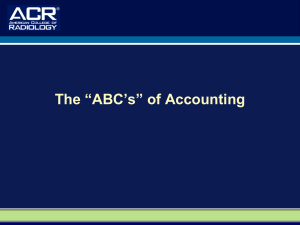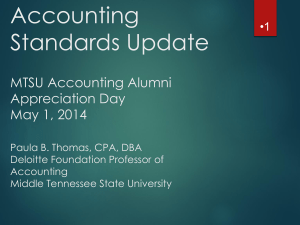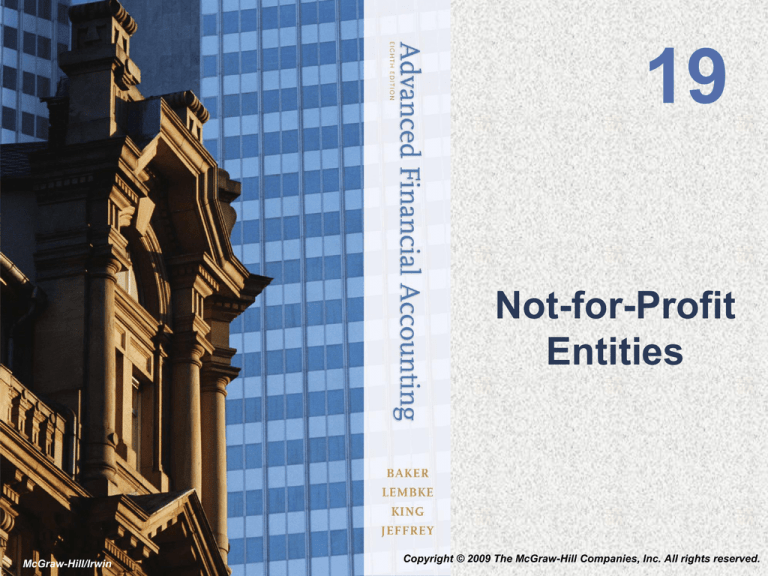
19
Not-for-Profit
Entities
McGraw-Hill/Irwin
Copyright © 2009 The McGraw-Hill Companies, Inc. All rights reserved.
Not-for-Profit Entities
•
•
The accounting and financial reporting for
governmental, nonprofit entities is controlled
by the Governmental Accounting Standards
Board (GASB)
Accounting and financial reporting for
nongovernmental, nonprofit entities is
controlled by the Financial Accounting
Standards Board (FASB)
– Important to determine the role the
government has in the organization
19-2
Financial Reporting for Private,
Not-for-Profit Entities
•
•
Private, not-for-profit entities must report
their net assets in accordance with FAC 6
FAC 6 specifies three mutually exclusive
classes of net assets:
– Unrestricted net assets
– Temporarily restricted net assets
– Permanently restricted net assets
19-3
Financial Reporting for Private,
Not-for-Profit Entities
•
•
Some not-for-profit entities use a fund
structure to account for each type of net
asset class
Other not-for-profit entities maintain only an
accounting record to show the amounts in
each net asset class
– The specific identification of any restricted
asset must be made when the asset comes
into the entity, generally by donation or
bequest
19-4
Financial Reporting for Private,
Not-for-Profit Entities
•
Important FASB Standards
– FASB 93 guides depreciation
– FASB 116 guides accounting for contributions
– FASB 117 establishes financial display
requirements
– FASB 124 establishes the accounting for
investments
– FASB 136 guides the accounting for transfers
of assets to a not-for-profit organization that
raises or holds contributions for others
19-5
Financial Reporting for Private,
Not-for-Profit Entities
•
Mergers and acquisitions – Exposure drafts
– The proposed standards:
•
•
•
Require the recognition of identifiable assets
acquired and liabilities assumed at their fair
values at the date of the acquisition
Require that intangible assets other than
goodwill and goodwill be assigned to reporting
units that are acquired
Approaches to evaluating goodwill impairment:
– Qualitative Evaluation Method
– Fair-Value-Based Evaluation
19-6
Colleges and Universities
•
Special conventions of revenue and
expenditure recognition
– Tuition and fee remissions/waivers and
uncollectible accounts
•
•
The full amount of the standard rate for tuition
and fees is recognized as revenue
Accounting for university-sponsored
scholarships, fellowships, tuition and fee
remissions or waivers depends on whether the
recipient provides any services to the university
19-7
Colleges and Universities
•
Special conventions of revenue and
expenditure recognition
– Tuition and fee reimbursements for
withdrawals from coursework
•
Accounted for as a reduction of revenue
– Academic terms that span two fiscal periods
•
•
Accounted for as revenue in the fiscal year in
which the term is predominantly conducted,
along with all expenses incurred
NACUBO recommended the use of the accrual
basis of accounting
19-8
Colleges and Universities
•
Board-designated funds
– The board may designate unrestricted current
fund resources for specific purposes
– FASB 117 specifies that these funds may not
be reported as restricted net assets because
only external, donor-imposed restrictions can
result in restricted net assets
19-9
Colleges and Universities
•
Public colleges and universities
– Accounting and reporting is specified by the
GASB
– GASB 35 requires that they follow the
standards for governmental entities as
specified in GASB 34
– Most public institutions will be special-purpose
government entities engaged in only
business-type activities
– These entities present only the financial
statements required for enterprise funds and
then are included as component units of the
state government
19-10
Colleges and Universities
•
Private colleges and universities
– The FASB specifies the accounting and
financial reporting standards
– The three financial statements required are:
•
•
•
The statement of financial position
The statement of activities
The statement of cash flows
– They are free to select any account structure
that best serves their management and
financial reporting needs
19-11
Colleges and Universities
Overview of the Accounting and Reporting of Colleges and Universities
19-12
Colleges and Universities
Overview of the Accounting and Reporting of Colleges and Universities
19-13
Health Care Providers
•
Hospital accounting
– Investor-owned hospitals provide the same
types of financial reports as commercial
entities
– Not-for-profit hospitals present their financial
results using a specific format required by the
FASB
– Governmental hospitals follow the GASB’s
accounting and reporting requirements and
are considered special-purpose entities
engaged in business-type activities
19-14
Health Care Providers
•
Hospital fund structure
– Although not required to do so, many
hospitals have used a fund accounting
structure for accounting purposes
– Operating activities are carried on in the
general fund, and a series of restricted funds
can be used to account for assets whose use
has been restricted by the donor
19-15
Health Care Providers
Overview of Hospital Accounting and Reporting
19-16
Health Care Providers
•
Financial statements for a not-for-profit
hospital
– Separate, not-for-profit hospitals issue four
basic financial statements
•
•
•
•
The balance sheet
The statement of operations
The statement of changes in net assets
The statement of cash flows
19-17
Health Care Providers
•
Not-for-profit hospital - The balance sheet
– Presents the total assets, liabilities, and net
assets of the organization as a whole
•
Major accounts
– Receivables
– Investments
•
Initially recorded at cost if purchased or at fair
value at the date of receipt if received as a gift
– Plant assets
•
Property, plant, and equipment is reported with
any accumulated depreciation
19-18
Health Care Providers
•
Not-for-profit hospital - The balance sheet
– Assets whose use is limited
•
Separate disclosure should be made for assets
that have restrictions placed on their use
– Long-term debt
•
The hospital must also account for its long-term
debt and pay the principal and interest as it
becomes due
– Net Assets
•
(1) unrestricted net assets available (2)
temporarily restricted net assets available for
use, and (3) permanently restricted net assets
19-19
Health Care Providers
•
Not-for-profit hospital - The statement of
operations
– Also often termed “the statement of activities”
– Includes the revenues, expenses, gains and
losses, and other transactions affecting the
unrestricted net assets during the period
– Only general fund transactions are reported
– Should report an operating performance
indicator
19-20
Health Care Providers
•
Not-for-profit hospital – Major accounts in
the statement of operations
–
–
–
–
–
–
Net patient service revenue
Contractual adjustments
Income from ancillary programs
Interfund transfers
General fund expenses
Donations
19-21
Health Care Providers
•
Not-for-profit hospital – The statement of
changes in net assets
– It presents the changes in all three categories
of net assets: unrestricted, temporarily
restricted, and permanently restricted
•
Statement of cash flows
– Its format is similar to that for commercial
entities
19-22
Health Care Providers
•
Summary of hospital accounting and
financial reporting
– Major operating activities take place in the
general fund
– The restricted funds are holding funds that
transfer resources to the general fund for
expenditures upon satisfaction of their
respective restrictions
– General fund uses the accrual basis of
accounting
– Patient services revenue is reported at gross
amounts measured at standard billing rates
19-23
Health Care Providers
•
Summary of hospital accounting and
financial reporting
– A deduction for contractual adjustments is
then made to arrive at net patient services
revenue
– Other revenue is recognized for ongoing
nonpatient services
– Charity care services are presented only in
the footnotes; no revenue is recognized for
them
19-24
Health Care Providers
•
Summary of hospital accounting and
financial reporting
– Operating expenses in the general fund
include depreciation, bad debts, and the value
of recognized donated services that are in
support of the basic services of the hospital
– Not all donated services are recognized
– Donated property and equipment are typically
recorded in a restricted fund until placed into
service, at which time they are transferred to
the general fund
– Donated assets are recorded at fair values at
the date of gift
19-25
Voluntary Health and Welfare
Organizations
•
Voluntary health and welfare organizations
(VHWOs) provide a variety of social
services
– They solicit funds from the community at large
and typically provide their services for no fee
– VHWOs are typically audited
– The federal government normally provides
them tax-exempt status
19-26
Voluntary Health and Welfare
Organizations
•
Accounting for a VHWO
– Similar to other not-for-profit organizations
except for special financial statements that
report on the important aspects of VHWOs
– The accrual basis of accounting is required
– VHWOs have been free to use fund
accounting in their accounting and reporting
processes
19-27
Voluntary Health and Welfare
Organizations
•
Financial statements for a VHWO:
–
–
–
–
•
Statement of financial position
Statement of activities
Statement of cash flows
Statement of functional expenses
The statements are designed primarily for
those who are interested in the organization
as “outsiders”
19-28
Voluntary Health and Welfare
Organizations
•
Statement of financial position for a VHWO
– Major balance sheet accounts are as follows:
•
•
•
•
•
Pledges from donors
Investments
Land, buildings, and equipment
Liabilities
Net assets
19-29
Voluntary Health and Welfare
Organizations
•
Statement of activities
– The overall structure of the statement of
activities for voluntary health and welfare
organizations and other not-for-profit entities
should be very similar as a result of FASB 117
19-30
Voluntary Health and Welfare
Organizations
•
Statement of activities
– Public support
•
The primary source of funds is likely to be
contributions from individuals or organizations
that do not derive any direct benefit from the
VHWO for their gifts
– Revenues
•
Funds received in exchange for services
provided or other activities
– Gains
•
Gain or loss on sale of investments and other
assets
19-31
Voluntary Health and Welfare
Organizations
•
Statement of activities
– Donated materials and services
•
Should be recorded at fair value when received
– Expenses
•
Information about the major costs of providing
services to the public, fund-raising, and general
and administrative costs
– Costs of informational materials that include a
fund-raising appeal
•
Many VHWOs prefer to classify such costs as
program rather than fund-raising
19-32
Voluntary Health and Welfare
Organizations
•
Statement of cash flows
– The format of this statement is similar to that
for hospitals
•
Statement of functional expenses
– Details the items reported in the expenses
section of the statement of activities
19-33
Voluntary Health and Welfare
Organizations
•
Summary of Accounting and Financial
Reporting for VHWOs
– Reporting requirements are specified in FASB
116, FASB 117, and the AICPA Audit and
Accounting Guide for Not-for-Profit
Organizations
– The accrual basis of accounting is used
– Primary activities are reported in the
unrestricted asset class
19-34
Voluntary Health and Welfare
Organizations
•
Summary of Accounting and Financial
Reporting for VHWOs
– Resources restricted by the donor for specific
operating purposes or future periods are
reported as temporarily restricted assets
– Assets contributed by the donor with
permanent restrictions are reported as
permanently restricted assets
19-35
Other Not-for-Profit Entities
•
Examples of other not-for-profit
organizations (ONPOs):
19-36
Other Not-for-Profit Entities
•
Accounting for ONPOs
– In addition to FASB 116 and FASB 117, the
AICPA Audit Guide for Not-for-Profit
Organizations provides guidance for
accounting and financial reporting standards
– While accrual accounting is required for all
ONPOs, some small organizations operate on
a cash basis during the year and convert to an
accrual basis at year-end
19-37
Other Not-for-Profit Entities
•
Accounting for ONPOs
– With the adoption of FASB 116 and FASB
117, the procedures used by ONPOs and
VHWOs may move away from the traditional
funds used
– They may account for all transactions in a
single entity or by establishing separate
accounts for unrestricted, temporarily
restricted, and permanently restricted net
assets
19-38
Other Not-for-Profit Entities
•
Financial Statements of ONPOs
– Purpose: Explain how the available resources
have been used to carry out activities
– They should disclose the nature and source of
the resources acquired, any restrictions on the
resources, and the principal programs and
their costs
– They should also provide information on the
ability to continue to carry out objectives
– FASB 117 requires: (1) a statement of
financial position, (2) a statement of activities,
and (3) a statement of cash flows
19-39
Other Not-for-Profit Entities
•
Summary of Accounting and Financial
Reporting
– Accounting is similar to that for VHWOs
– The accrual basis of accounting is used
– When a large number of programs or a
number of very different types of programs are
part of the operations, it may be desirable to
prepare a statement of expenses by functional
area or major program as well
– As a result of FASB 116 and FASB 117, the
reporting requirements of ONPOs are
substantially the same as VHWOs
19-40

